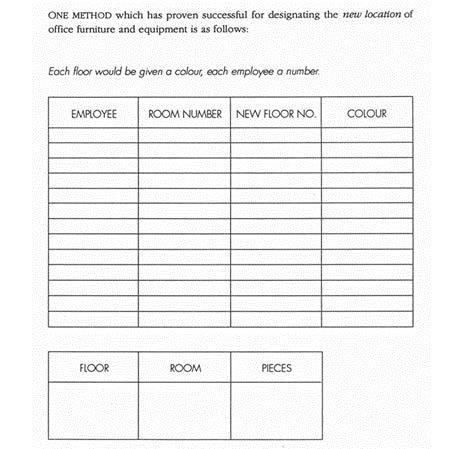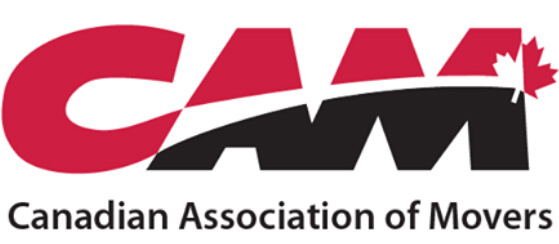Consumer Tip Sheet - Planning and Arranging the Relocation of an Office
There are many factors companies should consider when moving their offices. We hope this tip sheet helps you out with your planning. Discuss with your mover your particular game plan for a smooth move.
Develop a General Plan
• Notify and inform staff affected by move.
• Establish procedure outlining steps required to execute move.
• Establish time schedule for each stage. (see move check list for assistance)
• Distribute notice of move to immediate staff affected.
• Execute move.
Specific Details to Follow
1. Bolster the employee morale and eliminate grapevine rumours and future criticism of rearrangement by fully informing staff of new floor plan and layout.
2. Discuss with mover all details of the final floor plan and layout to develop economies in time and effectiveness.
3. Number and tag all furniture and equipment to be moved to a new location, relating a colour code label and floor plan placement (each number may also indicate the sequence of removal from old premises). The mover may also do this. Isolate "DO NOT MOVE" and "STORAGE" items.
4. Make sure floor plan layout clearly indicates distances between key pieces of furniture for rapid placement and positioning.
5. Produce a list of all pieces (inventory) to be moved identifying area, department, floor number and employee name. Integrate all new furniture into this list.
6. Telephone layout plan indicating position, type of instrument, extension number, hold buttons and intercom system.
7. Plan photocopier move with supplier of equipment.
8. Electrical work - prepare copy of existing layout with instructions for electrician to remove desk wires, wall clocks, intercom systems and water coolers, etc., that are to be moved.
9. Carpenters - instructions for removal of fixed accessories from present premises (i.e., suggestion boxes, mirrors, bulletin boards, fans, shelving). Check elevator capacity at both new and old locations in preparation for dismantling of equipment that is oversize.
10. Clean up - furniture, floors, etc., after installation.
Time schedule
Outside working hours are preferred in order to prevent disruption of jobs; establish day; estimate starting time; estimate working time and estimate the completion time of each of the following steps:
1. New furniture should be installed in place before moving in any existing furniture
2. Elevator time required
3. Final installation with telephone, photocopier, electricians and carpenters
Communication
• Information regarding all changes in locations, telephone numbers and locals, fax numbers, post office box numbers and e-mail should be published for use of other employees, outside workers and customers well in advance of change to new system to prevent dislocation of service.
• Mail Department - both incoming and outgoing and switchboard should be briefed.
• Lobby directory changes
Executing the Move
1. One week prior to the move do a general housecleaning, discarding all obsolete material according to a plan.
2. Develop instructions of how to pack, explaining that the maximum load per box is 60 pounds:
- Liquids that may spill or items that may be broken;
- Files that can be compressed in drawers and cabinets or alternatively removed from drawers and packed in cartons;
- Files and drawers that can be locked to prevent opening in transit;
- Fragile items that should be packed separately in box identified with code number of individual's desk (e.g., plants, pen sets, desk trays, etc.);
- Distribute tags to employees for their furniture and identify who is responsible for tagging (to be supervised by department head for assurance that each piece is tagged (See Figure 1 – Colour Codes);

- Designate one person in each department to be at the old location and another at the new location, each with a copy of the plan for moving by sequence; the person in new location will have a crew for positioning of furniture; follow plan to the letter.
3. Inform staff affected by move –
- What the general plan is;
- Show new building before move;
- Disseminate information on parking facilities, transit locations, etc.;
- Brochure explaining office and department layouts;
- Post floor plans in strategic location.
4. Making the move in stages is not desirable as breakup requires duplication of services in both old and new locations.
5. Order the new company stationery well in advance of the actual move.
6. Hold an open house - to maintain employee morale and company prestige; invite personalities and dignitaries, your key customers, in addition to employees and their families with local residents, to view the new premises.
Customer Check List
There are questions and problems that you will definitely have. Here is a check list that you can keep track of what needs to be done and, in many cases, will eliminate many of the questions and solve a great majority of their problems so that when moving day arrives, you will be well organized and prepared, making the move a lot easier. See appendix for the check list.
Additional Services
Sometimes even the most carefully thought-out endeavour will go amiss and some rearranging will be necessary. Any extra work that was not covered and agreed to in the original action plan should be discussed with your mover in order to find out what additional charges may occur. This will depend on the amount of extra work required and if extra men or supplies will be needed. The sooner you are able to advise the mover, the better. Of course, some work may not be known until the actual relocation has begun.
If Something Goes Wrong
Office moving is very complicated and getting more so every day. New types of furniture (modular, partitions, etc.) and sophisticated office equipment (large photocopy machines, collating machines, computers, etc.) as well as advanced design in facilities and buildings will always be a challenge to the mover, who must constantly increase knowledge and experience to meet these challenges.
Before making a claim to your moving company, know exactly what the moving company is liable for and what they aren’t. Refer to the inventory sheet and the tagging list created for the move as a reference to identify particular pieces of furniture. All claims should be substantiated by appropriate notations on the receipt for merchandise. Be aware that claims caused by the employee "reshuffling" of furniture after the move is completed are not the responsibility of the moving company.
Payment
Make sure that your company understands the payment plan and makes appropriate financial arrangements with the moving company before the move takes place and understand what will happen if there are additional services or a claim after the move.
Conclusion
Knowledge, planning, coordination and common sense will always be the best tools available to enable a satisfactory move. Communication with your chosen moving company is essential.

